好好好,好久不见,最近偶然了解到了pg_bulkload这一插件,然后花了点时间看了看它是如何实现的,又想到好久没有写东西了,咕了太久,有点怪不好意思的,所以决定写点东西,摆脱鸽子🕊的嫌疑。
一、pg_bulkload简单介绍
pg_bulkload 为PostgreSQL提供高速加载数据的插件。相关链接如下:
pg_bulkload内部结构图如下,后续章节我会以CSV格式文件,对pg_bulkload进行分析,源码分析从第四节开始,对前面比较熟悉的同学,可以直接调转至第四节。
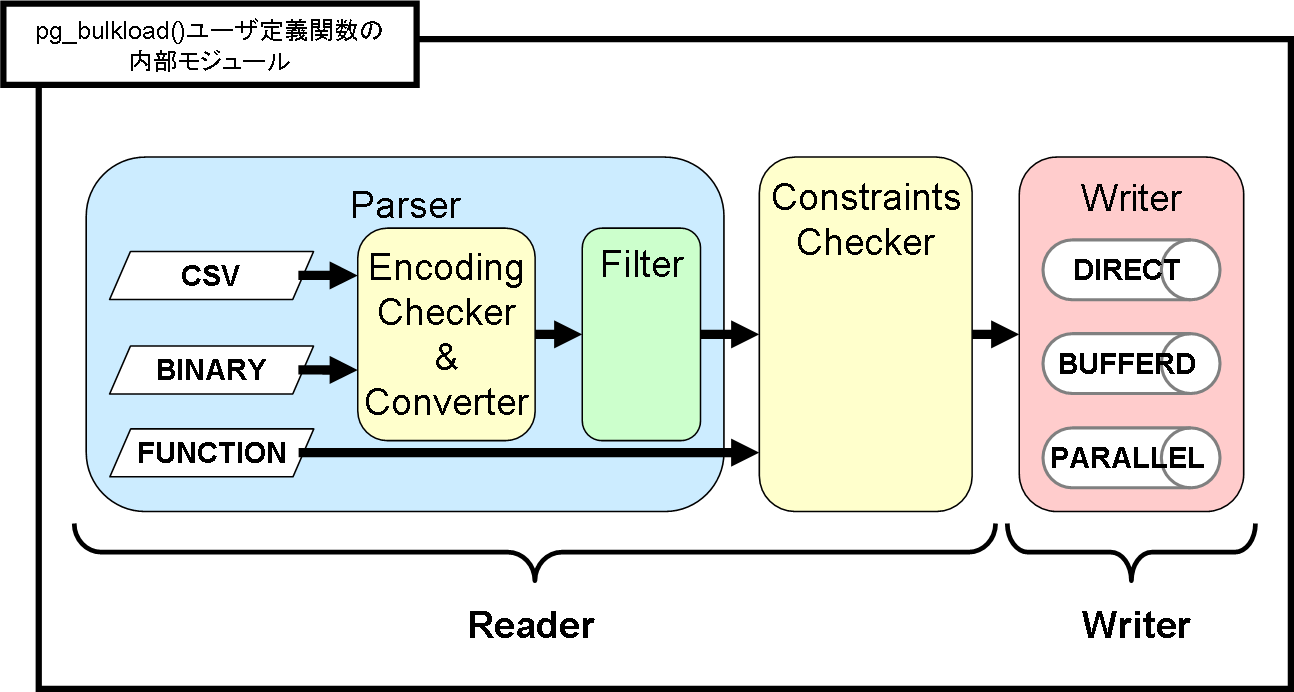
二、拓展插件安装
我此次采用的是源码安装,PostgreSQL版本14.10,你可以点击上述的pg_bulkload项目地址,下载源码文件,或者使用git clone命令,和我一同操作进行编译安装。
# 拉取pg_bulkload源代码
git clone https://github.com/ossc-db/pg_bulkload.git
# 进入源码目录
cd pg_bulkload/
# 如果此时你的源码下载路径不是位于PostgreSQL源码的contrib目录下可以使用以下命令进行编译安装
make USE_PGXS=1
make install 复制如果此时你的源码下载路径刚好是位于PostgreSQL的contrib目录下 此时使用make去编译 会存在一个编译的问题 编译不成功 大致报错如下(仅当前的版本的pg_bulkload)
make[1]: --pkglibdir: Command not found
gcc -Wall -Wmissing-prototypes -Wpointer-arith -Wdeclaration-after-statement -Werror=vla -Wendif-labels -Wmissing-format-attribute -Wimplicit-fallthrough=3 -Wcast-function-type -Wformat-security -fno-strict-aliasing -fwrapv -fexcess-precision=standard -Wno-format-truncation -Wno-stringop-truncation -g -O0 pg_bulkload.o recovery.o pgut/pgut.o pgut/pgut-fe.o pgut/pgut-list.o -L../../../src/port -L../../../src/common -Wl,--as-needed -Wl,-rpath,'/var/lib/pgsql/postgresql_14/lib',--enable-new-dtags -Wl,--build-id -L../../../src/interfaces/libpq -lpq -L -lpgcommon -lpgport -lz -lreadline -lpthread -lrt -ldl -lm -o pg_bulkload
pgut/pgut.o: In function `pgut_init':
/var/lib/pgsql/14code/postgres/contrib/pg_bulkload/bin/pgut/pgut.c:79: undefined reference to `set_pglocale_pgservice'
pgut/pgut.o: In function `prompt_for_password':
/var/lib/pgsql/14code/postgres/contrib/pg_bulkload/bin/pgut/pgut.c:395: undefined reference to `simple_prompt'
pgut/pgut-list.o: In function `new_list':
/var/lib/pgsql/14code/postgres/contrib/pg_bulkload/bin/pgut/pgut-list.c:114: undefined reference to `palloc'
pgut/pgut-list.o: In function `enlarge_list':
/var/lib/pgsql/14code/postgres/contrib/pg_bulkload/bin/pgut/pgut-list.c:174: undefined reference to `repalloc'
pgut/pgut-list.o: In function `list_free_private':
/var/lib/pgsql/14code/postgres/contrib/pg_bulkload/bin/pgut/pgut-list.c:1565: undefined reference to `pfree'
/var/lib/pgsql/14code/postgres/contrib/pg_bulkload/bin/pgut/pgut-list.c:1568: undefined reference to `pfree'
/var/lib/pgsql/14code/postgres/contrib/pg_bulkload/bin/pgut/pgut-list.c:1569: undefined reference to `pfree'
collect2: error: ld returned 1 exit status
make[1]: *** [../../../src/makefiles/pgxs.mk:475: pg_bulkload] Error 1
make[1]: Leaving directory '/var/lib/pgsql/14code/postgres/contrib/pg_bulkload/bin'
make: *** [Makefile:27: all] Error 2复制此时需要修改pg_bulkload下bin目录中的Makefile
cd pg_bulkload/
cd bin/
vim Makefile
# 你可以选择注释掉 PG_LIBS += -L$(shell $(PG_CONFIG) --pkglibdir) 或者是将
# ifdef USE_PGXS
# PG_CONFIG = pg_config
# PGXS := $(shell $(PG_CONFIG) --pgxs)
# 此处的PG_CONFIG = pg_config 放到ifdef前 我更倾向于第二种做法
# 修改完毕 进行编译
make && make install 复制我的Makefile修改如图所示
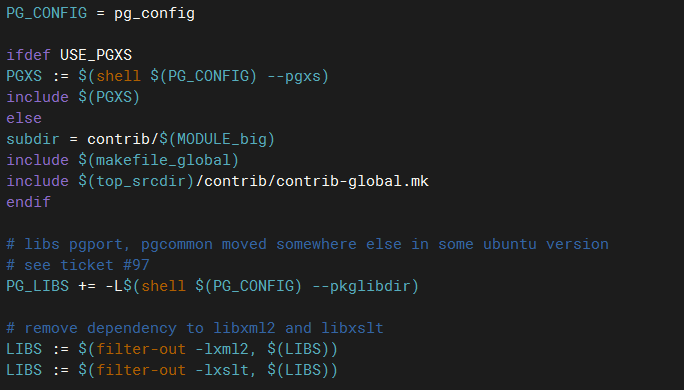
编译已通过、接下来进行插件安装,使用create extension pg_bulkload;即可
[postgres@halo-centos-8-release ~]$ psql
psql (14.10)
Type "help" for help.
postgres=# create extension pg_bulkload;
CREATE EXTENSION
postgres=# \dx
List of installed extensions
Name | Version | Schema | Description
-------------+---------+------------+-----------------------------------------------------------------
pg_bulkload | 3.1.21 | public | pg_bulkload is a high speed data loading utility for PostgreSQL
plpgsql | 1.0 | pg_catalog | PL/pgSQL procedural language
(2 rows)
postgres=# 复制三、简单使用
其实有很多大佬已经给出了非常详细的使用方式了,所以此处我就简单巴拉巴拉两嘴。
-- 使用halo用户在postgres数据库下 创建表foo
create table foo(a int, b varchar);
-- 退出数据库
\q复制生成点数据
seq 100000| awk '{print $0",foo"}' > foo.csv复制接下来使用pg_bulkload 导入数据,有两种方式,一种是不使用ctl文件
# 此处输入文件为foo.csv 输出对应到foo表 指定生成日志为test_foo.log 处理以csv的处理方式处理输入文件 分隔符为"," 端口号 数据库名 操作用户 依据自己的实际情况进行更改 [postgres@halo-centos-8-release ~]$ pg_bulkload -i ./foo.csv -O foo -l test_foo.log -p 5434 -o "TYPE=csv" -o "DELIMITER=," -d postgres -U halo NOTICE: BULK LOAD START NOTICE: BULK LOAD END 0 Rows skipped. 100000 Rows successfully loaded. 0 Rows not loaded due to parse errors. 0 Rows not loaded due to duplicate errors. 0 Rows replaced with new rows. # 查看日志 [postgres@halo-centos-8-release ~]$ cat test_foo.log pg_bulkload 3.1.21 on 2024-02-05 10:55:03.159387+08 INPUT = /var/lib/pgsql/foo.csv PARSE_BADFILE = /var/lib/pgsql/14/pg_bulkload/20240205105503_postgres_public_foo.prs.csv LOGFILE = /var/lib/pgsql/test_foo.log LIMIT = INFINITE PARSE_ERRORS = 0 CHECK_CONSTRAINTS = NO TYPE = CSV SKIP = 0 DELIMITER = , QUOTE = "\"" ESCAPE = "\"" NULL = OUTPUT = public.foo MULTI_PROCESS = NO VERBOSE = NO WRITER = DIRECT DUPLICATE_BADFILE = /var/lib/pgsql/14/pg_bulkload/20240205105503_postgres_public_foo.dup.csv DUPLICATE_ERRORS = 0 ON_DUPLICATE_KEEP = NEW TRUNCATE = NO 0 Rows skipped. 100000 Rows successfully loaded. 0 Rows not loaded due to parse errors. 0 Rows not loaded due to duplicate errors. 0 Rows replaced with new rows. Run began on 2024-02-05 10:55:03.159387+08 Run ended on 2024-02-05 10:55:03.218338+08 CPU 0.00s/0.05u sec elapsed 0.06 sec复制
第二种是编写ctl文件 将部分需要传入的参数写入ctl文件中
[postgres@halo-centos-8-release ~]$ vim sample_csv.ctl [postgres@halo-centos-8-release ~]$ cat sample_csv.ctl # # sample_csv.ctl -- Control file to load CSV input data # # Copyright (c) 2007-2024, NIPPON TELEGRAPH AND TELEPHONE CORPORATION # OUTPUT = foo # [<schema_name>.]table_name INPUT = /var/lib/pgsql/foo.csv # Input data location (absolute path) TYPE = CSV # Input file type QUOTE = "\"" # Quoting character ESCAPE = \ # Escape character for Quoting DELIMITER = "," # Delimiter [postgres@halo-centos-8-release ~]$ pg_bulkload ./sample_csv.ctl -d postgres -U halo NOTICE: BULK LOAD START NOTICE: BULK LOAD END 0 Rows skipped. 100000 Rows successfully loaded. 0 Rows not loaded due to parse errors. 0 Rows not loaded due to duplicate errors. 0 Rows replaced with new rows. [postgres@halo-centos-8-release ~]$复制
当然你也可以将ctl文件写的更加丰富详细 比如说是否在导数据前 执行truncate 是否需要跳过多少行数据 具体写入方式是什么之类的 具体可以参考pg_bulkload详细使用文档
[postgres@halo-centos-8-release ~]$ vim sample_csv.ctl [postgres@halo-centos-8-release ~]$ cat sample_csv.ctl OUTPUT = foo INPUT = /var/lib/pgsql/foo.csv LOGFILE = /var/lib/pgsql/test_table_foo.log LIMIT = INFINITE PARSE_ERRORS = 0 CHECK_CONSTRAINTS = NO TYPE = CSV SKIP = 0 DELIMITER = "," QUOTE = "\"" ESCAPE = "\"" MULTI_PROCESS = NO WRITER = DIRECT DUPLICATE_ERRORS = 0 ON_DUPLICATE_KEEP = NEW TRUNCATE = YES [postgres@halo-centos-8-release ~]$ pg_bulkload ./sample_csv.ctl -d postgres -U halo NOTICE: BULK LOAD START NOTICE: BULK LOAD END 0 Rows skipped. 100000 Rows successfully loaded. 0 Rows not loaded due to parse errors. 0 Rows not loaded due to duplicate errors. 0 Rows replaced with new rows. [postgres@halo-centos-8-release ~]$ cat test_table_foo.log pg_bulkload 3.1.21 on 2024-02-05 11:58:33.765146+08 INPUT = /var/lib/pgsql/foo.csv PARSE_BADFILE = /var/lib/pgsql/14/pg_bulkload/20240205115833_postgres_public_foo.prs.csv LOGFILE = /var/lib/pgsql/test_table_foo.log LIMIT = INFINITE PARSE_ERRORS = 0 CHECK_CONSTRAINTS = NO TYPE = CSV SKIP = 0 DELIMITER = , QUOTE = "\"" ESCAPE = "\"" NULL = OUTPUT = public.foo MULTI_PROCESS = NO VERBOSE = NO WRITER = DIRECT DUPLICATE_BADFILE = /var/lib/pgsql/14/pg_bulkload/20240205115833_postgres_public_foo.dup.csv DUPLICATE_ERRORS = 0 ON_DUPLICATE_KEEP = NEW TRUNCATE = YES 0 Rows skipped. 100000 Rows successfully loaded. 0 Rows not loaded due to parse errors. 0 Rows not loaded due to duplicate errors. 0 Rows replaced with new rows. Run began on 2024-02-05 11:58:33.765146+08 Run ended on 2024-02-05 11:58:33.827364+08 CPU 0.01s/0.05u sec elapsed 0.06 sec复制
四、简单分析pg_bulkload程序
接下来让我们来看看pg_bulkload到底是如何实现的?因此我们先来瞅瞅main函数(精简版本)/* main 函数精简之后大概就如下所示 大概五个部分 */
int main(int argc, char *argv[])
{
/* ...省略部分代码... */
pgut_init(argc, argv);
/* ...省略部分代码... */
i = pgut_getopt(argc, argv, options);
if (recovery)
{
/* ...省略部分代码... */
return LoaderRecoveryMain();
}
else
{
/* ...省略部分代码... */
if (control_file[0])
bulkload_options = list_concat(
ParseControlFile(control_file), bulkload_options);
/* ...省略部分代码... */
return LoaderLoadMain(bulkload_options);
}
}复制4.1、pgut_init
初始化函数做一些相关的初始化的动作,注意些处理函数,此处不展开。
4.2、pgut_getopt
解析传入的命令行相关选项,此函数精简一下 如下所示
int pgut_getopt(int argc, char **argv, pgut_option options[])
{
/* Help message and version are handled at first. */
/* ...省略部分代码... */
/* Merge default and user options. */
longopts = option_merge(default_options, options);
optstring = longopts_to_optstring(longopts);
/* Assign named options */
while ((c = getopt_long(argc, argv, optstring, longopts, &optindex)) != -1)
{
opt = option_find(c, default_options, options);
pgut_setopt(opt, optarg, SOURCE_CMDLINE);
}
/* ...省略部分代码... */
}复制而此处的支持处理的default_options和options分别是
static pgut_option default_options[] =
{
{ 'b', 'e', "echo" , &pgut_echo },
{ 'f', 'E', "elevel" , set_elevel },
{ 's', 'd', "dbname" , &dbname },
{ 's', 'h', "host" , &host },
{ 's', 'p', "port" , &port },
{ 's', 'U', "username" , &username },
{ 'Y', 'w', "no-password" , &prompt_password },
{ 'y', 'W', "password" , &prompt_password },
{ 0 }
};
static pgut_option options[] =
{
/* Dataload options */
{ 's', 'i', "infile" , &infile },
{ 's', 'i', "input" , &input },
{ 's', 'O', "output" , &output },
{ 's', 'l', "logfile" , &logfile },
{ 's', 'P', "parse-badfile" , &parse_badfile },
{ 's', 'u', "duplicate-badfile" , &duplicate_badfile },
{ 'f', 'o', "option" , parse_option },
/* Recovery options */
{ 's', 'D', "pgdata" , &DataDir },
{ 'b', 'r', "recovery" , &recovery },
{ 0 }
};复制当经过option_merge和longopts_to_optstring 此时能够支持处理的选项就变成了eE:d:h:p:U:wWi:i:O:l:P:u:o:D:r
然后再配合getopt_long、option_find和pgut_setopt将传入的相关信息保存到程序中,如pg_bulkload -i ./foo.csv -O foo -l test_foo.log -p 5434 -o "TYPE=csv" -o "DELIMITER=," -d postgres -U halo 中的-U halo选项,
getopt_long函数识别并返回字符'U'的ASCii码 85
option_find函数根据'U'的ASCii码 找到对应的pgut_option的结构体对象
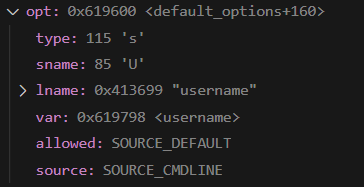
pgut_setopt函数再将对应的var的值 也就是对应的全局变量username的值 修改成传入的数据"halo",其他以此类推

4.3、ParseControlFile
解析控制文件,也就是ctl文件,如pg_bulkload ./sample_csv.ctl -d postgres -U halo 中的sample_csv.ctl文件
在执行ParseControlFile函数前 如果不是绝对路径 会先获取完整的绝对路径
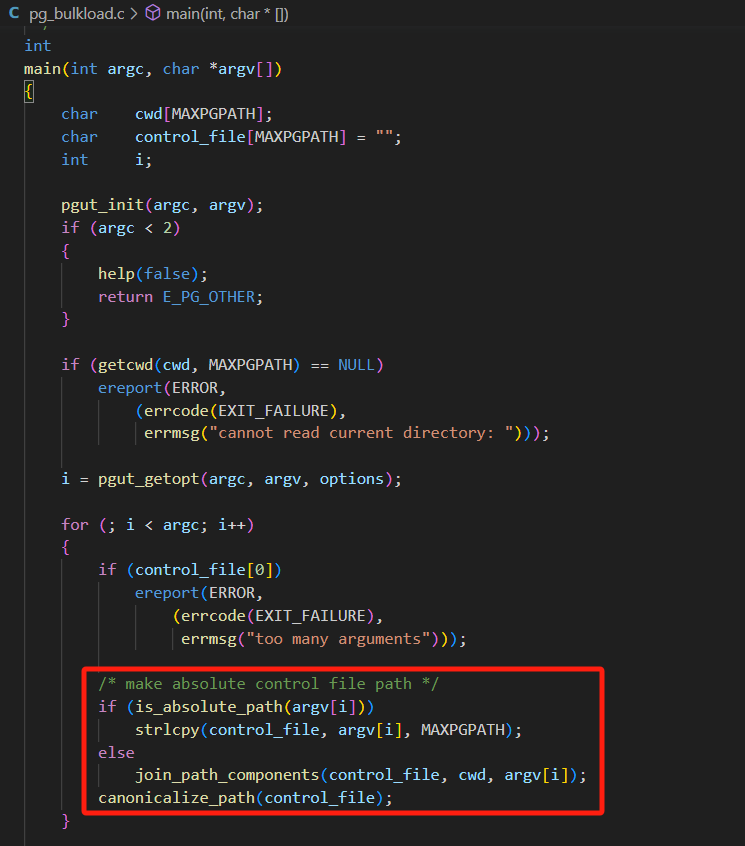
接着回到ParseControlFile函数 输入参数即为之前获取到的绝对路径
static List * ParseControlFile(const char *path)
{
/* ...省略部分代码... */
file = pgut_fopen(path, "rt");
for (lineno = 1; fgets(buf, LINEBUF, file); lineno++)
{
/* ...省略部分代码... */
for (i = 0; i < NUM_PATH_OPTIONS; i++)
{
pgut_option *opt = &options[i];
if (pgut_keyeq(keyword, opt->lname))
{
pgut_setopt(opt, value, SOURCE_FILE);
break;
}
}
/* Other options */
if (i >= NUM_PATH_OPTIONS)
{
size_t len;
char *item;
len = strlen(keyword) + strlen(value) + 2;
item = pgut_malloc(len);
snprintf(item, len, "%s=%s", keyword, value);
items = lappend(items, item);
if (pg_strcasecmp(item, "TYPE=FUNCTION") == 0)
type_function = true;
if (pg_strcasecmp(item, "TYPE=BINARY") == 0 ||
pg_strcasecmp(item, "TYPE=FIXED") == 0)
type_binary = true;
if (pg_strcasecmp(item, "WRITER=BINARY") == 0)
writer_binary = true;
}
}
fclose(file);
/* ...省略部分代码... */
}复制这个函数由于和pgut_getopt 类似 所以提到LoaderRecoveryMain函数之前 他的处理逻辑其实就是通过fgets函数一行一行的获取数据 然后去解析 最后和pgut_getopt 函数一样 通过pgut_setopt去设置相关数据
由于#define NUM_PATH_OPTIONS 6此处他仅仅匹配处理这六个参数
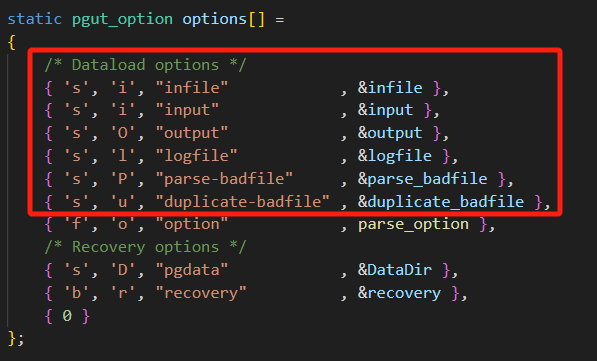
当超过六个时 他会当成Other options处理,会lappend保留相关数据用于后续处理 同时判断处理类型 或者 写入方式,此处不涉及Recovery options
4.4、LoaderRecoveryMain
此函数用于进行数据恢复,本次描述主要pg_bulkload是如何进行加载数据,感兴趣的同学可以自行查看学习此函数。
4.5、LoaderLoadMain
来到LoaderLoadMain函数,前面讲了相关的参数解析 一直都还没到最终处理 官方提供的pg_bulkload内部结构图也并没有得到体现 那么pg_bulkload内部结构图是否就体现在这个函数中呢?我们接着再来瞅瞅
static int LoaderLoadMain(List *options)
{
/* ...省略部分代码... */
reconnect(ERROR);
/* ...省略部分代码... */
/* form options as text[] */
appendStringInfoString(&buf, "{\"");
foreach (cell, options)
{
const char *item = lfirst(cell);
if (buf.len > 2)
appendStringInfoString(&buf, "\",\"");
/* escape " and \ */
while (*item)
{
if (*item == '"' || *item == '\\')
{
appendStringInfoChar(&buf, '\\');
appendStringInfoChar(&buf, *item);
item++;
}
else if (!IS_HIGHBIT_SET(*item))
{
appendStringInfoChar(&buf, *item);
item++;
}
else
{
int n = PQmblen(item, encoding);
appendBinaryStringInfo(&buf, item, n);
item += n;
}
}
}
appendStringInfoString(&buf, "\"}");
command("BEGIN", 0, NULL);
params[0] = buf.data;
res = execute("SELECT * FROM pgbulkload.pg_bulkload($1)", 1, params);
if (PQresultStatus(res) == PGRES_COPY_IN)
{
PQclear(res);
res = RemoteLoad(connection, stdin, type_binary);
if (PQresultStatus(res) != PGRES_TUPLES_OK)
elog(ERROR, "copy failed: %s", PQerrorMessage(connection));
}
command("COMMIT", 0, NULL);
errors = atoi(PQgetvalue(res, 0, 2)) + /* parse errors */
atoi(PQgetvalue(res, 0, 3)); /* duplicate errors */
elog(NOTICE, "BULK LOAD END\n"
"\t%s Rows skipped.\n"
"\t%s Rows successfully loaded.\n"
"\t%s Rows not loaded due to parse errors.\n"
"\t%s Rows not loaded due to duplicate errors.\n"
"\t%s Rows replaced with new rows.",
PQgetvalue(res, 0, 0), PQgetvalue(res, 0, 1),
PQgetvalue(res, 0, 2), PQgetvalue(res, 0, 3),
PQgetvalue(res, 0, 4));
PQclear(res);
disconnect();
termStringInfo(&buf);
/* ...省略部分代码... */
}复制可以看到的是如果简单分成三段的话 其实就是通过reconnect获取了一个新的连接 然后执行了一个名为pgbulkload.pg_bulkload的数据库函数 完成之后打印出我们熟悉的身影BULK LOAD END ... 并调用disconnect关闭连接。
而reconnect通过先前解析存储的username、dbname等数据通过pgut_connect 最后调用libpq的接口PQconnectdb获取到了新的连接
void reconnect(int elevel)
{
/* ...省略部分代码... */
if (dbname && dbname[0])
escape_param_str(&buf, "dbname", dbname);
if (host && host[0])
escape_param_str(&buf, "host", host);
if (port && port[0])
escape_param_str(&buf, "port", port);
if (username && username[0])
escape_param_str(&buf, "user", username);
if (password && password[0])
escape_param_str(&buf, "password", password);
connection = pgut_connect(buf.data, prompt_password, elevel); /* pgut_connect --》conn = PQconnectdb(info); */
/* ...省略部分代码... */
}复制那么截至目前我们也并没有看到pg_bulkload内部结构图有所体现 而通过execute--》pgut_execute--》pgut_execute_elevel--》PQexecParams调用pgbulkload.pg_bulkload之后 就能打印最终的处理结果了 那看样子pgbulkload.pg_bulkload才是真正的pg_bulkload程序
pgbulkload.pg_bulkload是pg_bulkload插件中创建的一个函数,创建语句如下:
CREATE SCHEMA pgbulkload; CREATE FUNCTION pgbulkload.pg_bulkload( IN options text[], OUT skip bigint, OUT count bigint, OUT parse_errors bigint, OUT duplicate_new bigint, OUT duplicate_old bigint, OUT system_time float8, OUT user_time float8, OUT duration float8 ) AS '$libdir/pg_bulkload', 'pg_bulkload' LANGUAGE C VOLATILE STRICT;复制
而这一段则是在构造pgbulkload.pg_bulkload 输入参数options text[]
/* form options as text[] */
appendStringInfoString(&buf, "{\"");
foreach (cell, options)
{
const char *item = lfirst(cell);
if (buf.len > 2)
appendStringInfoString(&buf, "\",\"");
/* escape " and \ */
while (*item)
{
if (*item == '"' || *item == '\\')
{
appendStringInfoChar(&buf, '\\');
appendStringInfoChar(&buf, *item);
item++;
}
else if (!IS_HIGHBIT_SET(*item))
{
appendStringInfoChar(&buf, *item);
item++;
}
else
{
int n = PQmblen(item, encoding);
appendBinaryStringInfo(&buf, item, n);
item += n;
}
}
}
appendStringInfoString(&buf, "\"}");复制当执行完之后SELECT * FROM pgbulkload.pg_bulkload之后,就解析返回的out参数的数据,然后就有了类似如下的显示
NOTICE: BULK LOAD START
NOTICE: BULK LOAD END
0 Rows skipped.
100000 Rows successfully loaded.
0 Rows not loaded due to parse errors.
0 Rows not loaded due to duplicate errors.
0 Rows replaced with new rows.复制五、简单分析pgbulkload.pg_bulkload函数
接下来让我们瞅瞅pgbulkload.pg_bulkload对应的c函数的具体实现
Datum pg_bulkload(PG_FUNCTION_ARGS)
{
Reader *rd = NULL;
Writer *wt = NULL;
/* ...省略部分代码... */
/*
* STEP 1: Initialization
*/
/* parse options and create reader and writer */
ParseOptions(options, &rd, &wt, ru0.tv.tv_sec);
/* initialize reader */
ReaderInit(rd);
/*
* We need to split PG_TRY block because gcc optimizes if-branches with
* longjmp codes too much. Local variables initialized in either branch
* cannot be handled another branch.
*/
PG_TRY();
{
/* truncate heap */
if (wt->truncate)
TruncateTable(wt->relid);
/* initialize writer */
WriterInit(wt);
/* initialize checker */
CheckerInit(&rd->checker, wt->rel, wt->tchecker);
/* initialize parser */
ParserInit(rd->parser, &rd->checker, rd->infile, wt->desc,
wt->multi_process, PG_GET_COLLATION());
}
PG_CATCH();
{
if (rd)
ReaderClose(rd, true);
if (wt)
WriterClose(wt, true);
PG_RE_THROW();
}
PG_END_TRY();
/* No throwable codes here! */
PG_TRY();
{
/* create logger */
CreateLogger(rd->logfile, wt->verbose, rd->infile[0] == ':');
start = timeval_to_cstring(ru0.tv);
LoggerLog(INFO, "\npg_bulkload %s on %s\n\n",
PG_BULKLOAD_VERSION, start);
ReaderDumpParams(rd);
WriterDumpParams(wt);
LoggerLog(INFO, "\n");
BULKLOAD_PROFILE(&prof_init);
/*
* STEP 2: Build heap
*/
/* Switch into its memory context */
Assert(wt->context);
ctx = MemoryContextSwitchTo(wt->context);
/* Loop for each input file record. */
while (wt->count < rd->limit)
{
HeapTuple tuple;
CHECK_FOR_INTERRUPTS();
/* read tuple */
BULKLOAD_PROFILE_PUSH();
tuple = ReaderNext(rd);
BULKLOAD_PROFILE_POP();
BULKLOAD_PROFILE(&prof_reader);
if (tuple == NULL)
break;
/* write tuple */
BULKLOAD_PROFILE_PUSH();
WriterInsert(wt, tuple);
wt->count += 1;
BULKLOAD_PROFILE_POP();
BULKLOAD_PROFILE(&prof_writer);
MemoryContextReset(wt->context);
BULKLOAD_PROFILE(&prof_reset);
}
MemoryContextSwitchTo(ctx);
/*
* STEP 3: Finalize heap and merge indexes
*/
count = wt->count;
parse_errors = rd->parse_errors;
/*
* close writer first and reader second because shmem_exit callback
* is managed by a simple stack.
*/
ret = WriterClose(wt, false);
wt = NULL;
skip = ReaderClose(rd, false);
rd = NULL;
}
PG_CATCH();
{
ErrorData *errdata;
MemoryContext ecxt;
ecxt = MemoryContextSwitchTo(ccxt);
errdata = CopyErrorData();
LoggerLog(INFO, "%s\n", errdata->message);
FreeErrorData(errdata);
/* close writer first, and reader second */
if (wt)
WriterClose(wt, true);
if (rd)
ReaderClose(rd, true);
MemoryContextSwitchTo(ecxt);
PG_RE_THROW();
}
PG_END_TRY();
count -= ret.num_dup_new;
LoggerLog(INFO, "\n"
" " int64_FMT " Rows skipped.\n"
" " int64_FMT " Rows successfully loaded.\n"
" " int64_FMT " Rows not loaded due to parse errors.\n"
" " int64_FMT " Rows not loaded due to duplicate errors.\n"
" " int64_FMT " Rows replaced with new rows.\n\n",
skip, count, parse_errors, ret.num_dup_new, ret.num_dup_old);
pg_rusage_init(&ru1);
system = diffTime(ru1.ru.ru_stime, ru0.ru.ru_stime);
user = diffTime(ru1.ru.ru_utime, ru0.ru.ru_utime);
duration = diffTime(ru1.tv, ru0.tv);
end = timeval_to_cstring(ru1.tv);
memset(nulls, 0, sizeof(nulls));
values[0] = Int64GetDatum(skip);
values[1] = Int64GetDatum(count);
values[2] = Int64GetDatum(parse_errors);
values[3] = Int64GetDatum(ret.num_dup_new);
values[4] = Int64GetDatum(ret.num_dup_old);
values[5] = Float8GetDatumFast(system);
values[6] = Float8GetDatumFast(user);
values[7] = Float8GetDatumFast(duration);
LoggerLog(INFO,
"Run began on %s\n"
"Run ended on %s\n\n"
"CPU %.2fs/%.2fu sec elapsed %.2f sec\n",
start, end, system, user, duration);
LoggerClose();
result = heap_form_tuple(tupdesc, values, nulls);
BULKLOAD_PROFILE(&prof_fini);
BULKLOAD_PROFILE_POP();
BULKLOAD_PROFILE_PRINT();
PG_RETURN_DATUM(HeapTupleGetDatum(result));
}复制不难看出整个函数就三个步骤,如果顺带对应着pg_bulkload内部结构图来看的话 其实就能很好的理解了

按照结构图来看其实就分为Reader,Writer。然后Reader的Parser支持处理三种类型,如果是csv、binary这些格式,Reader的Parser还会承当一些检查转换过滤的操作,然后经过约束检查之后就可以交由Writer了,而Writer也同时支持三种处理。
那么如何确认Reader的Parser是处理什么类型的以及Writer应该以什么样的方式插入呢?所以整个工作就交由了Initialization
5.1、Initialization
对于如何确认Reader的Parser是处理什么类型的以及Writer应该以什么样的方式插入呢,我们可以看一下ParseOptions函数
/* parse options and create reader and writer */
ParseOptions(options, &rd, &wt, ru0.tv.tv_sec);复制它用于解析和创建reader and writer 内部解析处理代码如下
/* parse for each option */
defs = untransformRelOptions(options);
foreach (cell, defs)
{
opt = lfirst(cell);
if (opt->arg == NULL)
ereport(ERROR, (errcode(ERRCODE_INVALID_PARAMETER_VALUE),
errmsg("option \"%s\" has no value", opt->defname)));
keyword = opt->defname;
value = strVal(opt->arg);
if (CompareKeyword(keyword, "TYPE"))
{
ASSERT_ONCE(type == NULL);
type = value;
}
else if (CompareKeyword(keyword, "WRITER") ||
CompareKeyword(keyword, "LOADER"))
{
ASSERT_ONCE(writer == NULL);
writer = value;
}
else if (CompareKeyword(keyword, "MULTI_PROCESS"))
{
multi_process = ParseBoolean(value);
}
else
{
rest_defs = lappend(rest_defs, opt);
continue;
}
}
*wt = WriterCreate(writer, multi_process);
*rd = ReaderCreate(type);复制再来看看WriterCreate、ReaderCreate
Writer *
WriterCreate(char *writer, bool multi_process)
{
const char *keys[] =
{
"DIRECT",
"BUFFERED",
"BINARY"
};
const CreateWriter values[] =
{
CreateDirectWriter,
CreateBufferedWriter,
CreateBinaryWriter
};
Writer *self;
/* default of writer is DIRECT */
if (writer == NULL)
writer = "DIRECT";
/* alias for backward compatibility. */
if (pg_strcasecmp(writer, "PARALLEL") == 0)
{
multi_process = true;
writer = "DIRECT";
}
self = values[choice("WRITER", writer, keys, lengthof(keys))](NULL);
if (multi_process)
self = CreateParallelWriter(self);
self->multi_process = multi_process;
return self;
}
Reader *
ReaderCreate(char *type)
{
const char *keys[] =
{
"BINARY",
"FIXED", /* alias for backward compatibility. */
"CSV",
"TUPLE",
"FUNCTION",
};
const ParserCreate values[] =
{
CreateBinaryParser,
CreateBinaryParser,
CreateCSVParser,
CreateTupleParser,
CreateFunctionParser,
};
Reader *self;
/* default of type is CSV */
if (type == NULL)
type = "CSV";
self = palloc0(sizeof(Reader));
self->max_parse_errors = -2;
self->limit = INT64_MAX;
self->checker.encoding = -1;
self->parser = values[choice("TYPE", type, keys, lengthof(keys))]();
return self;
}复制可以看到完完全全和结构图对应上了,再多的内容就不展开了,后续就是对应的初始化指针初始化reader(parser、checker)、writer ,如果是设置了导数据前先truncate 也是在初始化阶段执行的 ,以及创建对应的logger 用于输出日志
/* initialize reader */
ReaderInit(rd);
/*
* We need to split PG_TRY block because gcc optimizes if-branches with
* longjmp codes too much. Local variables initialized in either branch
* cannot be handled another branch.
*/
PG_TRY();
{
/* truncate heap */
if (wt->truncate)
TruncateTable(wt->relid);
/* initialize writer */
WriterInit(wt);
/* initialize checker */
CheckerInit(&rd->checker, wt->rel, wt->tchecker);
/* initialize parser */
ParserInit(rd->parser, &rd->checker, rd->infile, wt->desc,
wt->multi_process, PG_GET_COLLATION());
}
PG_CATCH();
{
if (rd)
ReaderClose(rd, true);
if (wt)
WriterClose(wt, true);
PG_RE_THROW();
}
PG_END_TRY();
/* ...省略部分代码... */
/* create logger */
CreateLogger(rd->logfile, wt->verbose, rd->infile[0] == ':');
start = timeval_to_cstring(ru0.tv);
LoggerLog(INFO, "\npg_bulkload %s on %s\n\n",
PG_BULKLOAD_VERSION, start);
ReaderDumpParams(rd);
WriterDumpParams(wt);
LoggerLog(INFO, "\n");复制5.2、Build heap
这个部分的代码很清晰,这个阶段就是由Reader读取解析数据生成元组(关系型数据库的基础概念)检查校验完之后 然后交由Writer使用指定的方式插入指定的表中
/* Loop for each input file record. */
while (wt->count < rd->limit)
{
HeapTuple tuple;
CHECK_FOR_INTERRUPTS();
/* read tuple */
BULKLOAD_PROFILE_PUSH();
tuple = ReaderNext(rd);
BULKLOAD_PROFILE_POP();
BULKLOAD_PROFILE(&prof_reader);
if (tuple == NULL)
break;
/* write tuple */
BULKLOAD_PROFILE_PUSH();
WriterInsert(wt, tuple);
wt->count += 1;
BULKLOAD_PROFILE_POP();
BULKLOAD_PROFILE(&prof_writer);
MemoryContextReset(wt->context);
BULKLOAD_PROFILE(&prof_reset);
}复制ReaderNext函数
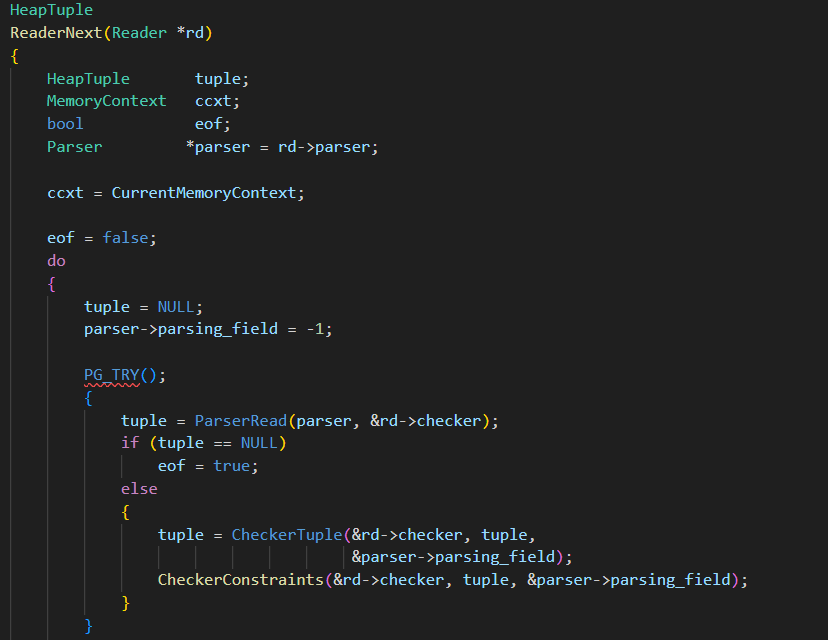
5.3、Finalize heap and merge indexes
这一部分就是完成对writer、reader的清理、记录一些日志数据、还有一步就是生成最终的返回元组,完成函数调用,就此闭环了。
/* close writer first, and reader second */
if (wt)
WriterClose(wt, true);
if (rd)
ReaderClose(rd, true)复制 LoggerLog(INFO, "\n"
" " int64_FMT " Rows skipped.\n"
" " int64_FMT " Rows successfully loaded.\n"
" " int64_FMT " Rows not loaded due to parse errors.\n"
" " int64_FMT " Rows not loaded due to duplicate errors.\n"
" " int64_FMT " Rows replaced with new rows.\n\n",
skip, count, parse_errors, ret.num_dup_new, ret.num_dup_old);
pg_rusage_init(&ru1);
system = diffTime(ru1.ru.ru_stime, ru0.ru.ru_stime);
user = diffTime(ru1.ru.ru_utime, ru0.ru.ru_utime);
duration = diffTime(ru1.tv, ru0.tv);
end = timeval_to_cstring(ru1.tv);
memset(nulls, 0, sizeof(nulls));
values[0] = Int64GetDatum(skip);
values[1] = Int64GetDatum(count);
values[2] = Int64GetDatum(parse_errors);
values[3] = Int64GetDatum(ret.num_dup_new);
values[4] = Int64GetDatum(ret.num_dup_old);
values[5] = Float8GetDatumFast(system);
values[6] = Float8GetDatumFast(user);
values[7] = Float8GetDatumFast(duration);
LoggerLog(INFO,
"Run began on %s\n"
"Run ended on %s\n\n"
"CPU %.2fs/%.2fu sec elapsed %.2f sec\n",
start, end, system, user, duration);
LoggerClose();
result = heap_form_tuple(tupdesc, values, nulls);
BULKLOAD_PROFILE(&prof_fini);
BULKLOAD_PROFILE_POP();
BULKLOAD_PROFILE_PRINT();
PG_RETURN_DATUM(HeapTupleGetDatum(result));复制六、总结
来个简单的总结 只是梳理了一下 pg_bulkload大概的加载数据的过程 具体细节方面 各位可以自行调试。
对于pg_bulkload程序而言,
主要就是依据解析到的信息创建数据库连接,
执行SELECT * FROM pgbulkload.pg_bulkload($1)
解析返回数据 关闭连接
其实主要就是调用pgbulkload.pg_bulkload数据库函数,和给出的pg_bulkload内部结构图没有什么太大的关系,
或者是说pgbulkload.pg_bulkload对应的c函数才是真正的意义上的"pg_bulkload"程序。
此处给出pg_bulkload程序的一个大概的执行流程图

此处给出pgbulkload.pg_bulkload数据库内核c函数的一个大概的执行流程图

七、声明
由于篇幅的原因诸多细节未完全展开(又是冗长的一篇... 这个篇幅还真是有点不好控制),若文中存在错误或不当之处,敬请指出,以便我进行修正和完善。希望这篇文章能够帮助到你。
文章转载请联系,谢谢合作。
文章被以下合辑收录
评论
 点赞
点赞 1
1










